Icon College: Business and Business Environment Report on Tesco
VerifiedAdded on 2022/12/30
|15
|4286
|37
Report
AI Summary
This report provides an in-depth analysis of Tesco's business and its environment. It begins by classifying organizations by sector and commercial orientation, differentiating between private and public sectors, and profit-oriented versus non-profit entities. It then examines the size and scope of organizations, using Tesco, HSBC, and Morgan Furniture as case studies, highlighting their stakeholders and legal structures. The report analyzes how these organizations interlink to achieve business objectives, such as Tesco collaborating with HSBC for financial services and Morgan Furniture for product displays. It further explores the relationships between different organizational functions within Tesco, emphasizing its functional organizational structure, its advantages like operational speed and clarity, and disadvantages such as lack of coordination and external disputes. A PESTLE analysis is conducted to assess the macro-environmental factors affecting Tesco, including political, economic, and social influences, such as the impact of Brexit, economic conditions, consumer behavior, and the company's globalization strategy. Finally, a SWOT analysis is included to assess the strengths, weaknesses, opportunities, and threats impacting Tesco. The report covers various aspects of the business environment and its effect on Tesco.
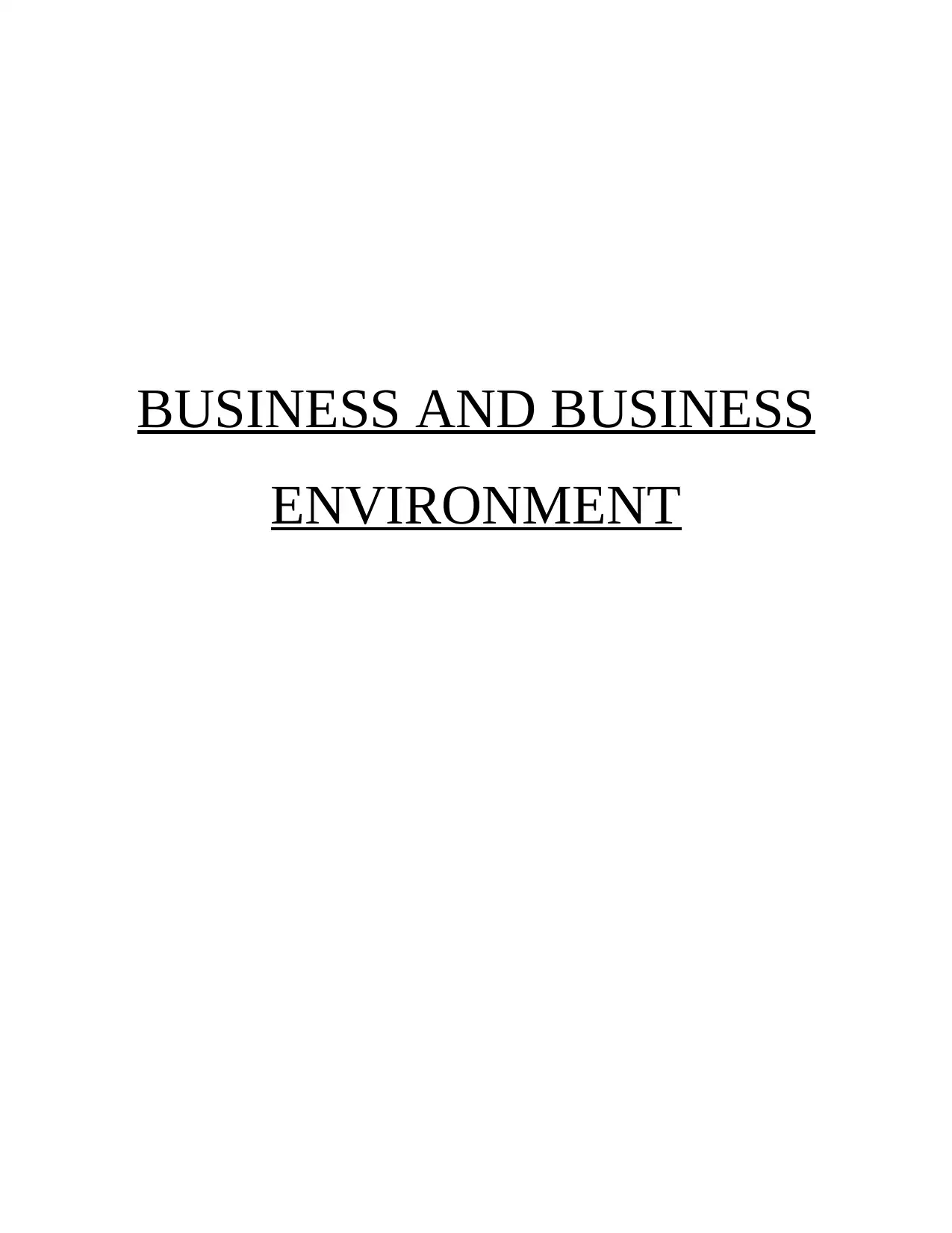
BUSINESS AND BUSINESS
ENVIRONMENT
ENVIRONMENT
Paraphrase This Document
Need a fresh take? Get an instant paraphrase of this document with our AI Paraphraser
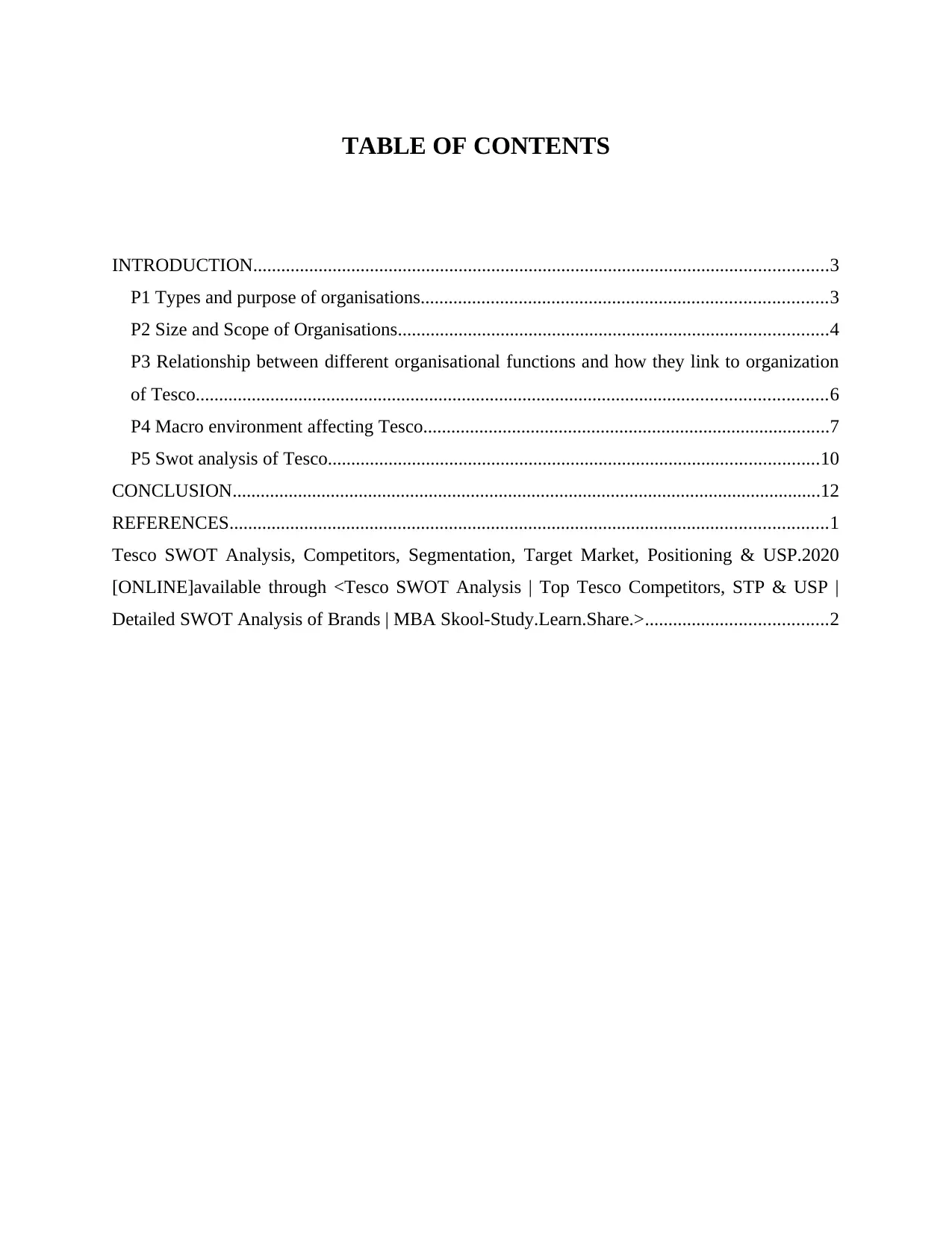
TABLE OF CONTENTS
INTRODUCTION...........................................................................................................................3
P1 Types and purpose of organisations.......................................................................................3
P2 Size and Scope of Organisations............................................................................................4
P3 Relationship between different organisational functions and how they link to organization
of Tesco.......................................................................................................................................6
P4 Macro environment affecting Tesco.......................................................................................7
P5 Swot analysis of Tesco.........................................................................................................10
CONCLUSION..............................................................................................................................12
REFERENCES................................................................................................................................1
Tesco SWOT Analysis, Competitors, Segmentation, Target Market, Positioning & USP.2020
[ONLINE]available through <Tesco SWOT Analysis | Top Tesco Competitors, STP & USP |
Detailed SWOT Analysis of Brands | MBA Skool-Study.Learn.Share.>.......................................2
INTRODUCTION...........................................................................................................................3
P1 Types and purpose of organisations.......................................................................................3
P2 Size and Scope of Organisations............................................................................................4
P3 Relationship between different organisational functions and how they link to organization
of Tesco.......................................................................................................................................6
P4 Macro environment affecting Tesco.......................................................................................7
P5 Swot analysis of Tesco.........................................................................................................10
CONCLUSION..............................................................................................................................12
REFERENCES................................................................................................................................1
Tesco SWOT Analysis, Competitors, Segmentation, Target Market, Positioning & USP.2020
[ONLINE]available through <Tesco SWOT Analysis | Top Tesco Competitors, STP & USP |
Detailed SWOT Analysis of Brands | MBA Skool-Study.Learn.Share.>.......................................2
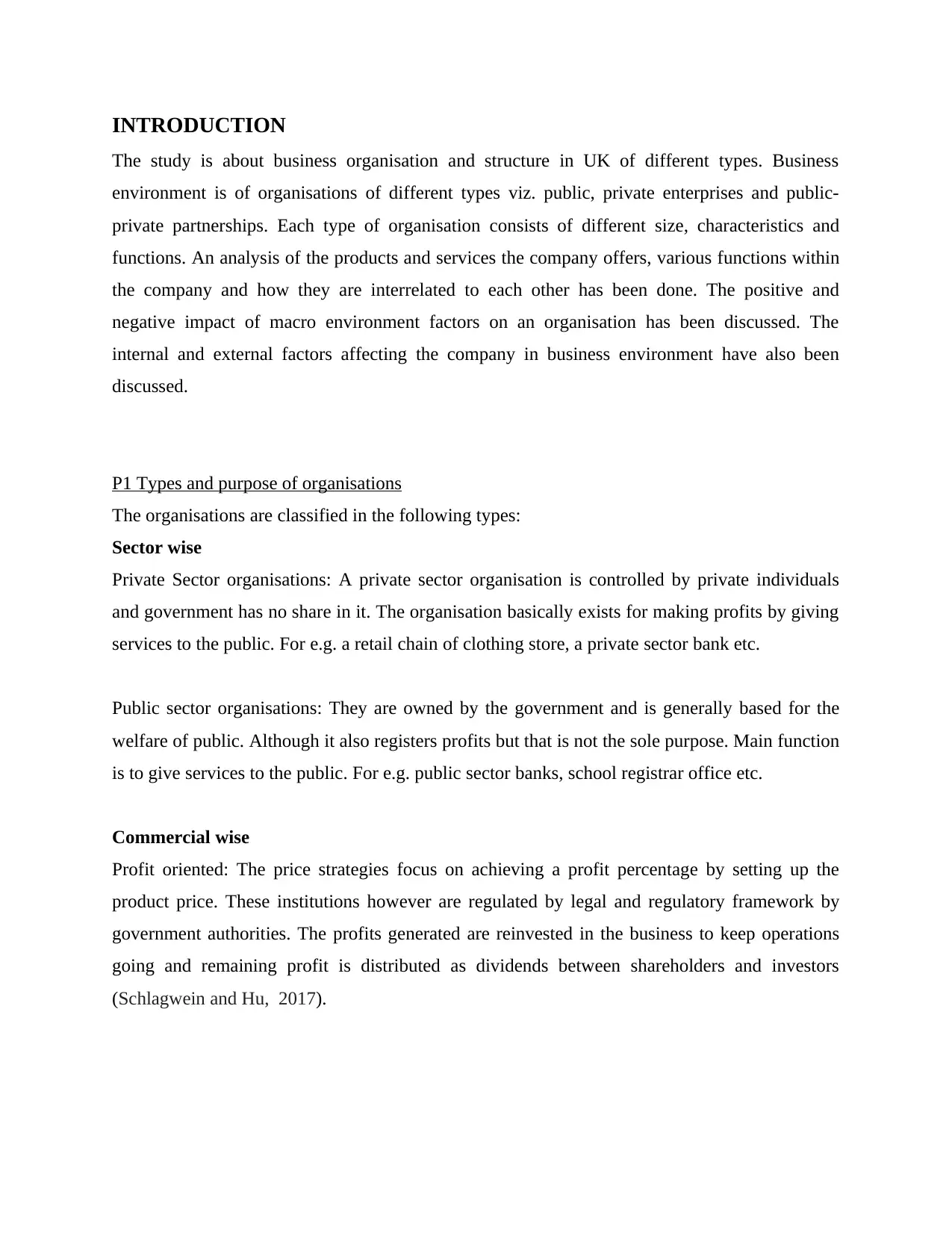
INTRODUCTION
The study is about business organisation and structure in UK of different types. Business
environment is of organisations of different types viz. public, private enterprises and public-
private partnerships. Each type of organisation consists of different size, characteristics and
functions. An analysis of the products and services the company offers, various functions within
the company and how they are interrelated to each other has been done. The positive and
negative impact of macro environment factors on an organisation has been discussed. The
internal and external factors affecting the company in business environment have also been
discussed.
P1 Types and purpose of organisations
The organisations are classified in the following types:
Sector wise
Private Sector organisations: A private sector organisation is controlled by private individuals
and government has no share in it. The organisation basically exists for making profits by giving
services to the public. For e.g. a retail chain of clothing store, a private sector bank etc.
Public sector organisations: They are owned by the government and is generally based for the
welfare of public. Although it also registers profits but that is not the sole purpose. Main function
is to give services to the public. For e.g. public sector banks, school registrar office etc.
Commercial wise
Profit oriented: The price strategies focus on achieving a profit percentage by setting up the
product price. These institutions however are regulated by legal and regulatory framework by
government authorities. The profits generated are reinvested in the business to keep operations
going and remaining profit is distributed as dividends between shareholders and investors
(Schlagwein and Hu, 2017).
The study is about business organisation and structure in UK of different types. Business
environment is of organisations of different types viz. public, private enterprises and public-
private partnerships. Each type of organisation consists of different size, characteristics and
functions. An analysis of the products and services the company offers, various functions within
the company and how they are interrelated to each other has been done. The positive and
negative impact of macro environment factors on an organisation has been discussed. The
internal and external factors affecting the company in business environment have also been
discussed.
P1 Types and purpose of organisations
The organisations are classified in the following types:
Sector wise
Private Sector organisations: A private sector organisation is controlled by private individuals
and government has no share in it. The organisation basically exists for making profits by giving
services to the public. For e.g. a retail chain of clothing store, a private sector bank etc.
Public sector organisations: They are owned by the government and is generally based for the
welfare of public. Although it also registers profits but that is not the sole purpose. Main function
is to give services to the public. For e.g. public sector banks, school registrar office etc.
Commercial wise
Profit oriented: The price strategies focus on achieving a profit percentage by setting up the
product price. These institutions however are regulated by legal and regulatory framework by
government authorities. The profits generated are reinvested in the business to keep operations
going and remaining profit is distributed as dividends between shareholders and investors
(Schlagwein and Hu, 2017).
⊘ This is a preview!⊘
Do you want full access?
Subscribe today to unlock all pages.

Trusted by 1+ million students worldwide
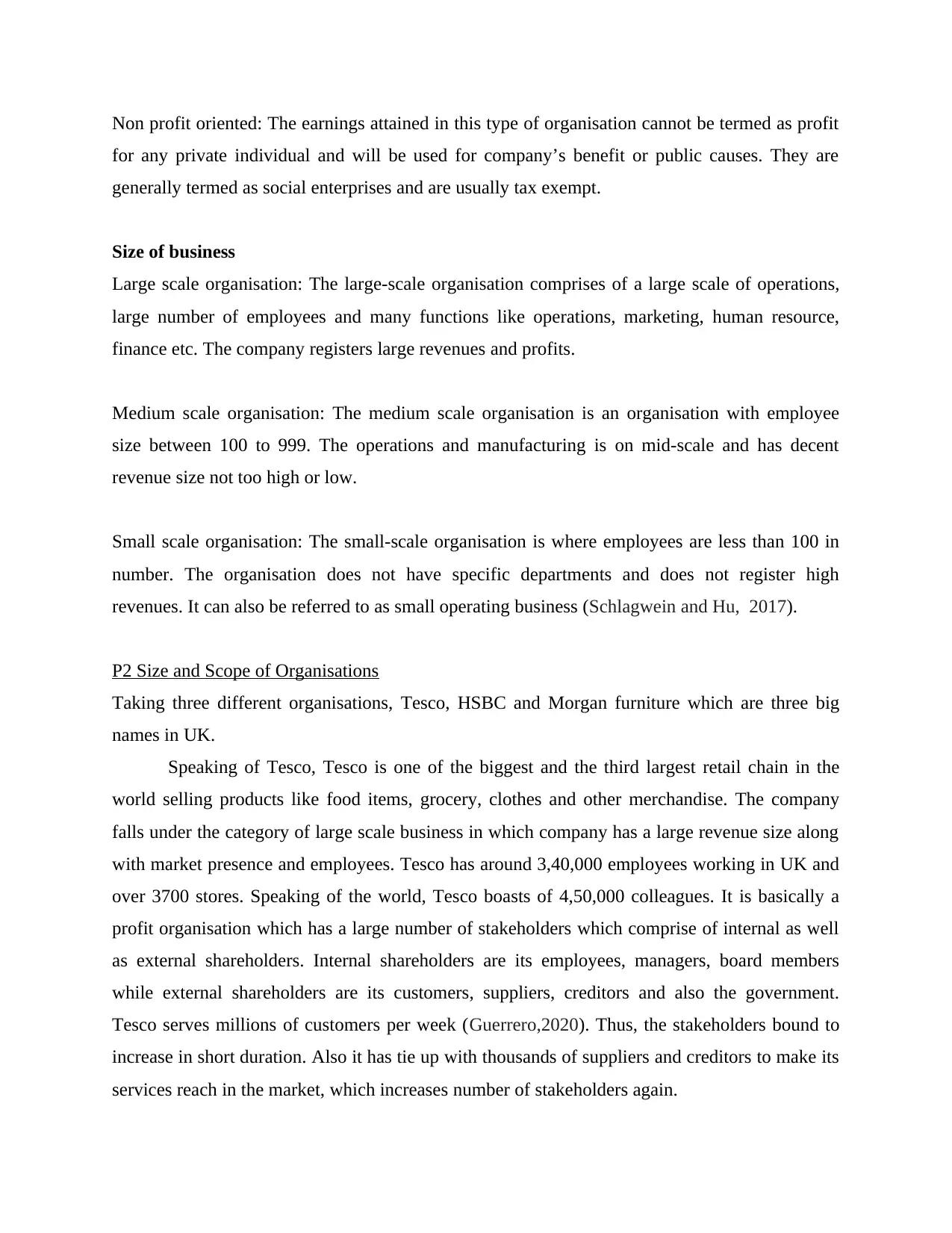
Non profit oriented: The earnings attained in this type of organisation cannot be termed as profit
for any private individual and will be used for company’s benefit or public causes. They are
generally termed as social enterprises and are usually tax exempt.
Size of business
Large scale organisation: The large-scale organisation comprises of a large scale of operations,
large number of employees and many functions like operations, marketing, human resource,
finance etc. The company registers large revenues and profits.
Medium scale organisation: The medium scale organisation is an organisation with employee
size between 100 to 999. The operations and manufacturing is on mid-scale and has decent
revenue size not too high or low.
Small scale organisation: The small-scale organisation is where employees are less than 100 in
number. The organisation does not have specific departments and does not register high
revenues. It can also be referred to as small operating business (Schlagwein and Hu, 2017).
P2 Size and Scope of Organisations
Taking three different organisations, Tesco, HSBC and Morgan furniture which are three big
names in UK.
Speaking of Tesco, Tesco is one of the biggest and the third largest retail chain in the
world selling products like food items, grocery, clothes and other merchandise. The company
falls under the category of large scale business in which company has a large revenue size along
with market presence and employees. Tesco has around 3,40,000 employees working in UK and
over 3700 stores. Speaking of the world, Tesco boasts of 4,50,000 colleagues. It is basically a
profit organisation which has a large number of stakeholders which comprise of internal as well
as external shareholders. Internal shareholders are its employees, managers, board members
while external shareholders are its customers, suppliers, creditors and also the government.
Tesco serves millions of customers per week (Guerrero,2020). Thus, the stakeholders bound to
increase in short duration. Also it has tie up with thousands of suppliers and creditors to make its
services reach in the market, which increases number of stakeholders again.
for any private individual and will be used for company’s benefit or public causes. They are
generally termed as social enterprises and are usually tax exempt.
Size of business
Large scale organisation: The large-scale organisation comprises of a large scale of operations,
large number of employees and many functions like operations, marketing, human resource,
finance etc. The company registers large revenues and profits.
Medium scale organisation: The medium scale organisation is an organisation with employee
size between 100 to 999. The operations and manufacturing is on mid-scale and has decent
revenue size not too high or low.
Small scale organisation: The small-scale organisation is where employees are less than 100 in
number. The organisation does not have specific departments and does not register high
revenues. It can also be referred to as small operating business (Schlagwein and Hu, 2017).
P2 Size and Scope of Organisations
Taking three different organisations, Tesco, HSBC and Morgan furniture which are three big
names in UK.
Speaking of Tesco, Tesco is one of the biggest and the third largest retail chain in the
world selling products like food items, grocery, clothes and other merchandise. The company
falls under the category of large scale business in which company has a large revenue size along
with market presence and employees. Tesco has around 3,40,000 employees working in UK and
over 3700 stores. Speaking of the world, Tesco boasts of 4,50,000 colleagues. It is basically a
profit organisation which has a large number of stakeholders which comprise of internal as well
as external shareholders. Internal shareholders are its employees, managers, board members
while external shareholders are its customers, suppliers, creditors and also the government.
Tesco serves millions of customers per week (Guerrero,2020). Thus, the stakeholders bound to
increase in short duration. Also it has tie up with thousands of suppliers and creditors to make its
services reach in the market, which increases number of stakeholders again.
Paraphrase This Document
Need a fresh take? Get an instant paraphrase of this document with our AI Paraphraser
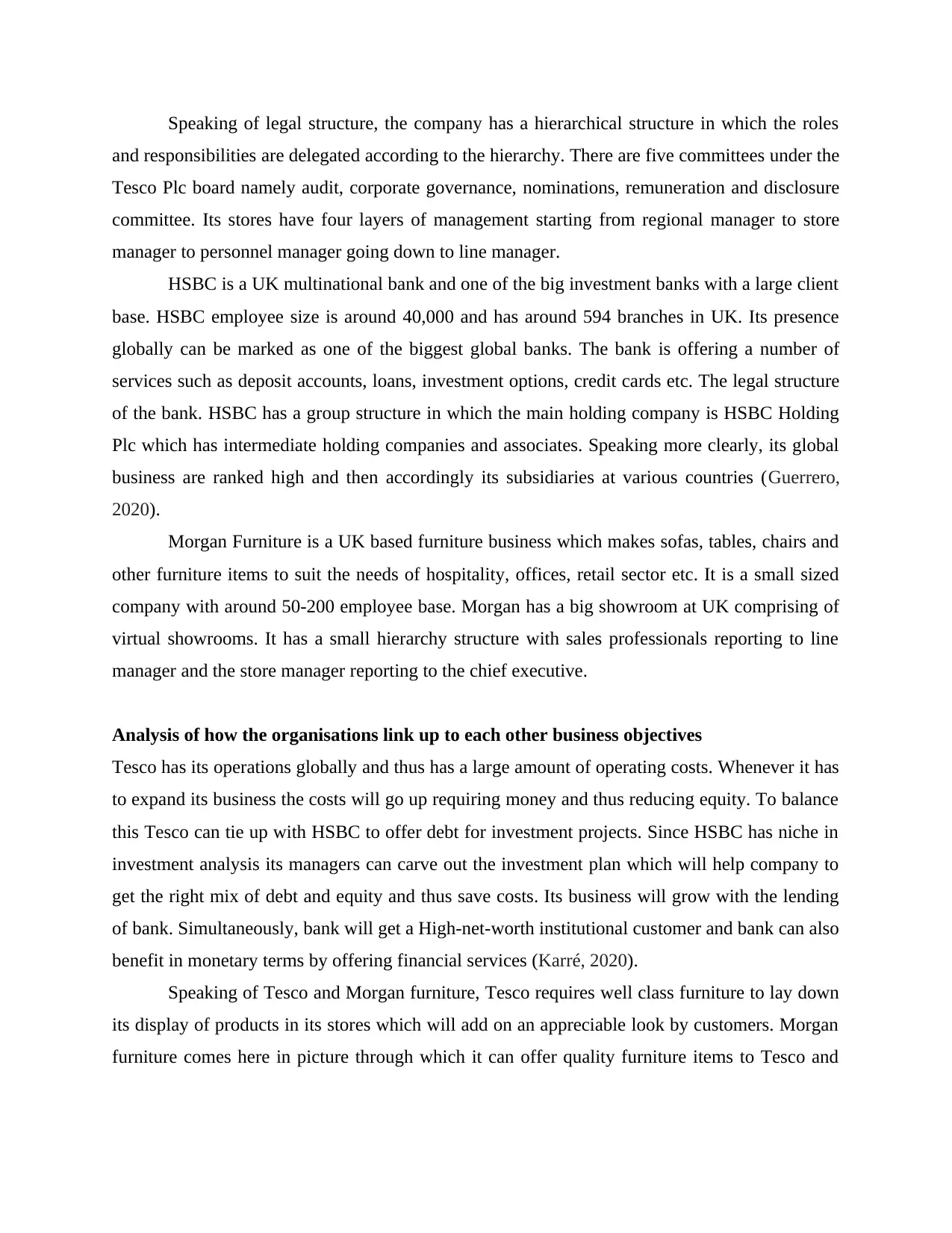
Speaking of legal structure, the company has a hierarchical structure in which the roles
and responsibilities are delegated according to the hierarchy. There are five committees under the
Tesco Plc board namely audit, corporate governance, nominations, remuneration and disclosure
committee. Its stores have four layers of management starting from regional manager to store
manager to personnel manager going down to line manager.
HSBC is a UK multinational bank and one of the big investment banks with a large client
base. HSBC employee size is around 40,000 and has around 594 branches in UK. Its presence
globally can be marked as one of the biggest global banks. The bank is offering a number of
services such as deposit accounts, loans, investment options, credit cards etc. The legal structure
of the bank. HSBC has a group structure in which the main holding company is HSBC Holding
Plc which has intermediate holding companies and associates. Speaking more clearly, its global
business are ranked high and then accordingly its subsidiaries at various countries (Guerrero,
2020).
Morgan Furniture is a UK based furniture business which makes sofas, tables, chairs and
other furniture items to suit the needs of hospitality, offices, retail sector etc. It is a small sized
company with around 50-200 employee base. Morgan has a big showroom at UK comprising of
virtual showrooms. It has a small hierarchy structure with sales professionals reporting to line
manager and the store manager reporting to the chief executive.
Analysis of how the organisations link up to each other business objectives
Tesco has its operations globally and thus has a large amount of operating costs. Whenever it has
to expand its business the costs will go up requiring money and thus reducing equity. To balance
this Tesco can tie up with HSBC to offer debt for investment projects. Since HSBC has niche in
investment analysis its managers can carve out the investment plan which will help company to
get the right mix of debt and equity and thus save costs. Its business will grow with the lending
of bank. Simultaneously, bank will get a High-net-worth institutional customer and bank can also
benefit in monetary terms by offering financial services (Karré, 2020).
Speaking of Tesco and Morgan furniture, Tesco requires well class furniture to lay down
its display of products in its stores which will add on an appreciable look by customers. Morgan
furniture comes here in picture through which it can offer quality furniture items to Tesco and
and responsibilities are delegated according to the hierarchy. There are five committees under the
Tesco Plc board namely audit, corporate governance, nominations, remuneration and disclosure
committee. Its stores have four layers of management starting from regional manager to store
manager to personnel manager going down to line manager.
HSBC is a UK multinational bank and one of the big investment banks with a large client
base. HSBC employee size is around 40,000 and has around 594 branches in UK. Its presence
globally can be marked as one of the biggest global banks. The bank is offering a number of
services such as deposit accounts, loans, investment options, credit cards etc. The legal structure
of the bank. HSBC has a group structure in which the main holding company is HSBC Holding
Plc which has intermediate holding companies and associates. Speaking more clearly, its global
business are ranked high and then accordingly its subsidiaries at various countries (Guerrero,
2020).
Morgan Furniture is a UK based furniture business which makes sofas, tables, chairs and
other furniture items to suit the needs of hospitality, offices, retail sector etc. It is a small sized
company with around 50-200 employee base. Morgan has a big showroom at UK comprising of
virtual showrooms. It has a small hierarchy structure with sales professionals reporting to line
manager and the store manager reporting to the chief executive.
Analysis of how the organisations link up to each other business objectives
Tesco has its operations globally and thus has a large amount of operating costs. Whenever it has
to expand its business the costs will go up requiring money and thus reducing equity. To balance
this Tesco can tie up with HSBC to offer debt for investment projects. Since HSBC has niche in
investment analysis its managers can carve out the investment plan which will help company to
get the right mix of debt and equity and thus save costs. Its business will grow with the lending
of bank. Simultaneously, bank will get a High-net-worth institutional customer and bank can also
benefit in monetary terms by offering financial services (Karré, 2020).
Speaking of Tesco and Morgan furniture, Tesco requires well class furniture to lay down
its display of products in its stores which will add on an appreciable look by customers. Morgan
furniture comes here in picture through which it can offer quality furniture items to Tesco and
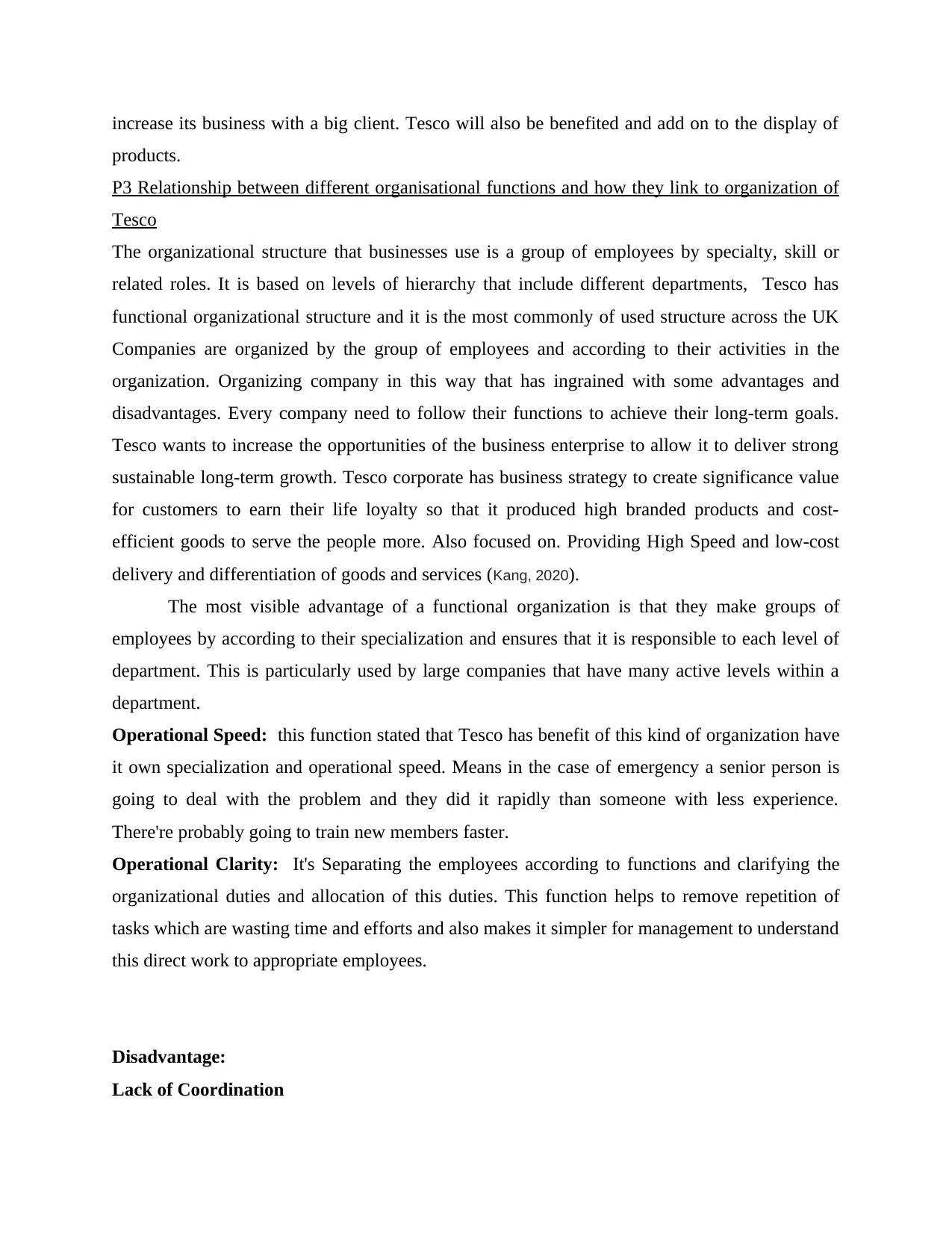
increase its business with a big client. Tesco will also be benefited and add on to the display of
products.
P3 Relationship between different organisational functions and how they link to organization of
Tesco
The organizational structure that businesses use is a group of employees by specialty, skill or
related roles. It is based on levels of hierarchy that include different departments, Tesco has
functional organizational structure and it is the most commonly of used structure across the UK
Companies are organized by the group of employees and according to their activities in the
organization. Organizing company in this way that has ingrained with some advantages and
disadvantages. Every company need to follow their functions to achieve their long-term goals.
Tesco wants to increase the opportunities of the business enterprise to allow it to deliver strong
sustainable long-term growth. Tesco corporate has business strategy to create significance value
for customers to earn their life loyalty so that it produced high branded products and cost-
efficient goods to serve the people more. Also focused on. Providing High Speed and low-cost
delivery and differentiation of goods and services (Kang, 2020).
The most visible advantage of a functional organization is that they make groups of
employees by according to their specialization and ensures that it is responsible to each level of
department. This is particularly used by large companies that have many active levels within a
department.
Operational Speed: this function stated that Tesco has benefit of this kind of organization have
it own specialization and operational speed. Means in the case of emergency a senior person is
going to deal with the problem and they did it rapidly than someone with less experience.
There're probably going to train new members faster.
Operational Clarity: It's Separating the employees according to functions and clarifying the
organizational duties and allocation of this duties. This function helps to remove repetition of
tasks which are wasting time and efforts and also makes it simpler for management to understand
this direct work to appropriate employees.
Disadvantage:
Lack of Coordination
products.
P3 Relationship between different organisational functions and how they link to organization of
Tesco
The organizational structure that businesses use is a group of employees by specialty, skill or
related roles. It is based on levels of hierarchy that include different departments, Tesco has
functional organizational structure and it is the most commonly of used structure across the UK
Companies are organized by the group of employees and according to their activities in the
organization. Organizing company in this way that has ingrained with some advantages and
disadvantages. Every company need to follow their functions to achieve their long-term goals.
Tesco wants to increase the opportunities of the business enterprise to allow it to deliver strong
sustainable long-term growth. Tesco corporate has business strategy to create significance value
for customers to earn their life loyalty so that it produced high branded products and cost-
efficient goods to serve the people more. Also focused on. Providing High Speed and low-cost
delivery and differentiation of goods and services (Kang, 2020).
The most visible advantage of a functional organization is that they make groups of
employees by according to their specialization and ensures that it is responsible to each level of
department. This is particularly used by large companies that have many active levels within a
department.
Operational Speed: this function stated that Tesco has benefit of this kind of organization have
it own specialization and operational speed. Means in the case of emergency a senior person is
going to deal with the problem and they did it rapidly than someone with less experience.
There're probably going to train new members faster.
Operational Clarity: It's Separating the employees according to functions and clarifying the
organizational duties and allocation of this duties. This function helps to remove repetition of
tasks which are wasting time and efforts and also makes it simpler for management to understand
this direct work to appropriate employees.
Disadvantage:
Lack of Coordination
⊘ This is a preview!⊘
Do you want full access?
Subscribe today to unlock all pages.

Trusted by 1+ million students worldwide
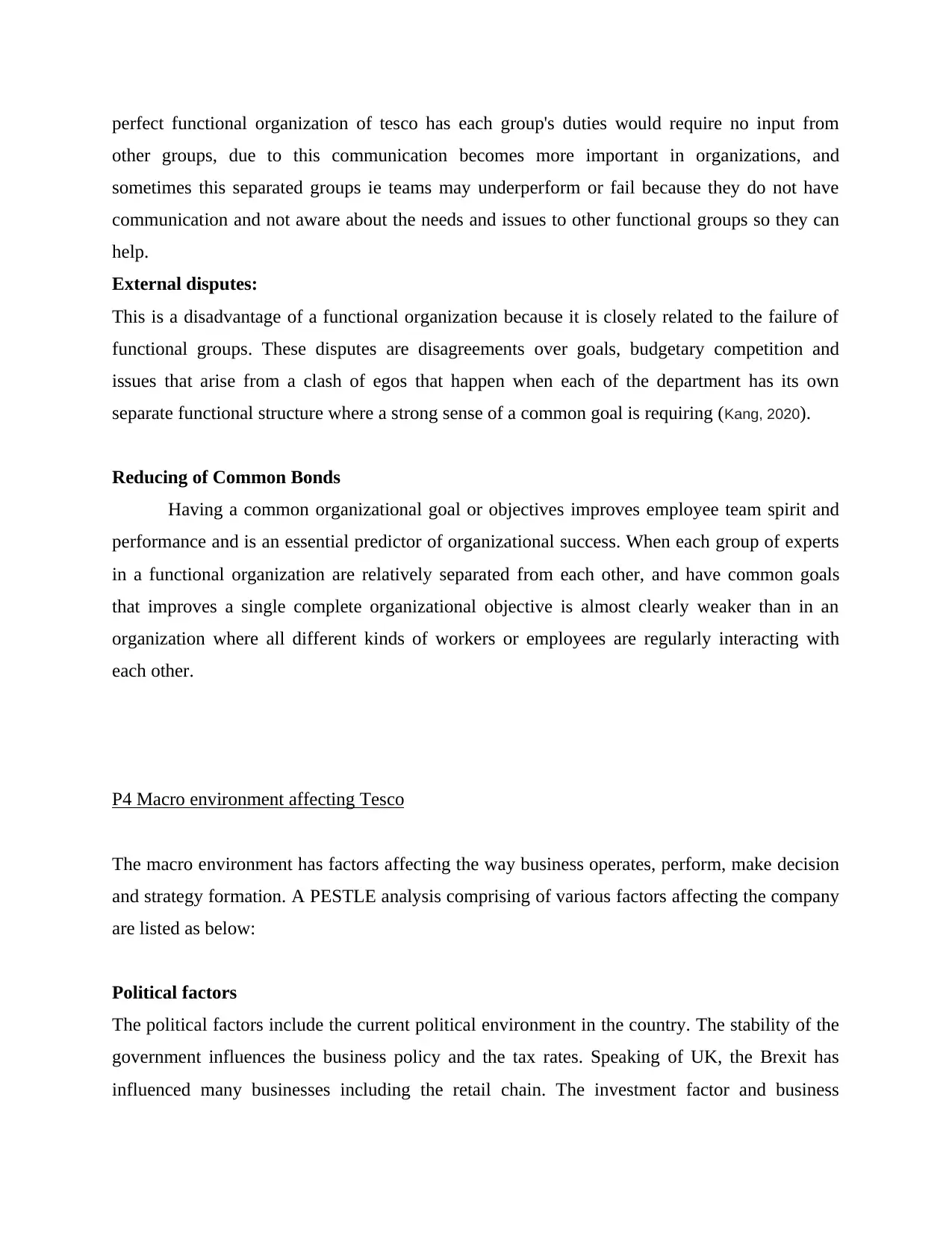
perfect functional organization of tesco has each group's duties would require no input from
other groups, due to this communication becomes more important in organizations, and
sometimes this separated groups ie teams may underperform or fail because they do not have
communication and not aware about the needs and issues to other functional groups so they can
help.
External disputes:
This is a disadvantage of a functional organization because it is closely related to the failure of
functional groups. These disputes are disagreements over goals, budgetary competition and
issues that arise from a clash of egos that happen when each of the department has its own
separate functional structure where a strong sense of a common goal is requiring (Kang, 2020).
Reducing of Common Bonds
Having a common organizational goal or objectives improves employee team spirit and
performance and is an essential predictor of organizational success. When each group of experts
in a functional organization are relatively separated from each other, and have common goals
that improves a single complete organizational objective is almost clearly weaker than in an
organization where all different kinds of workers or employees are regularly interacting with
each other.
P4 Macro environment affecting Tesco
The macro environment has factors affecting the way business operates, perform, make decision
and strategy formation. A PESTLE analysis comprising of various factors affecting the company
are listed as below:
Political factors
The political factors include the current political environment in the country. The stability of the
government influences the business policy and the tax rates. Speaking of UK, the Brexit has
influenced many businesses including the retail chain. The investment factor and business
other groups, due to this communication becomes more important in organizations, and
sometimes this separated groups ie teams may underperform or fail because they do not have
communication and not aware about the needs and issues to other functional groups so they can
help.
External disputes:
This is a disadvantage of a functional organization because it is closely related to the failure of
functional groups. These disputes are disagreements over goals, budgetary competition and
issues that arise from a clash of egos that happen when each of the department has its own
separate functional structure where a strong sense of a common goal is requiring (Kang, 2020).
Reducing of Common Bonds
Having a common organizational goal or objectives improves employee team spirit and
performance and is an essential predictor of organizational success. When each group of experts
in a functional organization are relatively separated from each other, and have common goals
that improves a single complete organizational objective is almost clearly weaker than in an
organization where all different kinds of workers or employees are regularly interacting with
each other.
P4 Macro environment affecting Tesco
The macro environment has factors affecting the way business operates, perform, make decision
and strategy formation. A PESTLE analysis comprising of various factors affecting the company
are listed as below:
Political factors
The political factors include the current political environment in the country. The stability of the
government influences the business policy and the tax rates. Speaking of UK, the Brexit has
influenced many businesses including the retail chain. The investment factor and business
Paraphrase This Document
Need a fresh take? Get an instant paraphrase of this document with our AI Paraphraser
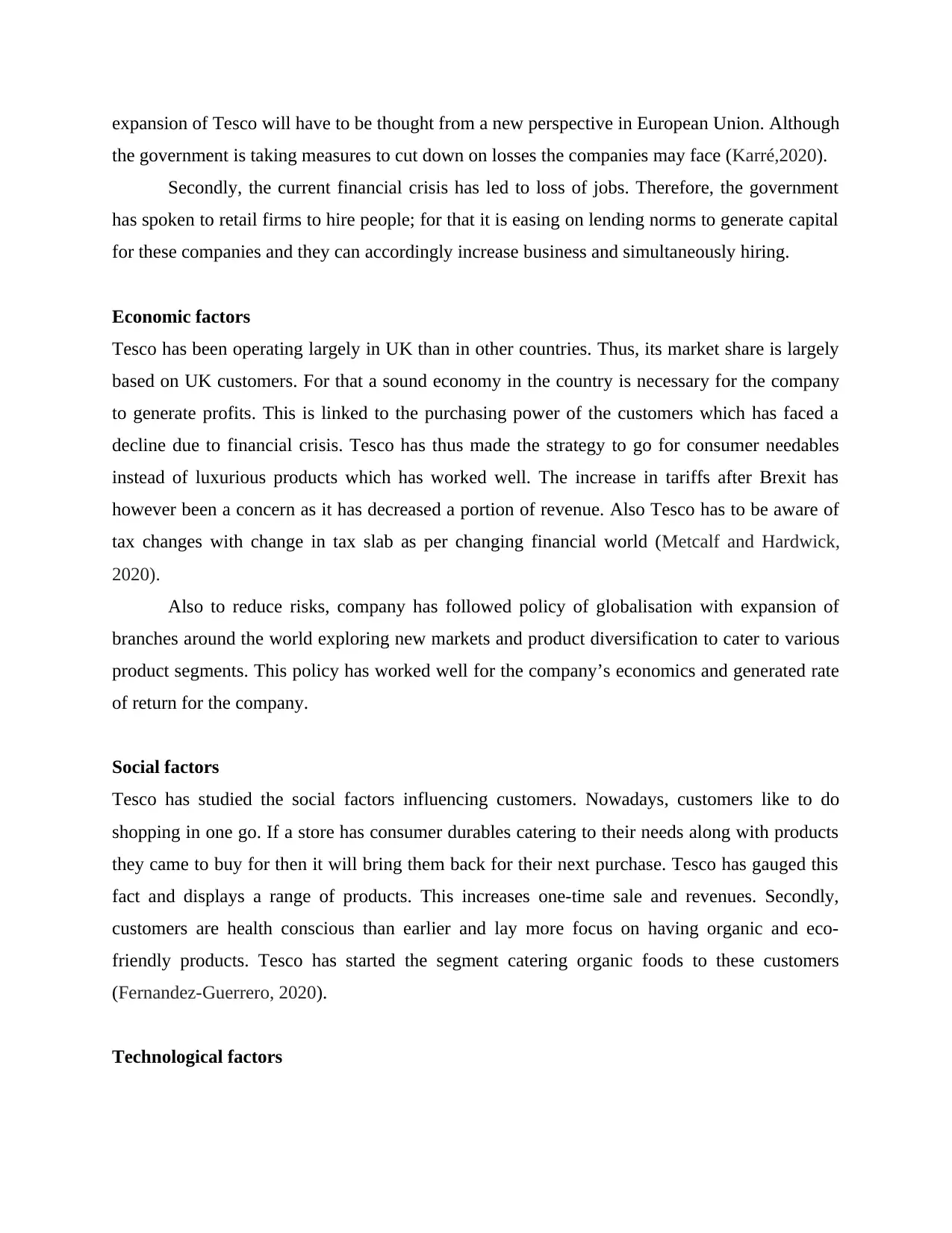
expansion of Tesco will have to be thought from a new perspective in European Union. Although
the government is taking measures to cut down on losses the companies may face (Karré,2020).
Secondly, the current financial crisis has led to loss of jobs. Therefore, the government
has spoken to retail firms to hire people; for that it is easing on lending norms to generate capital
for these companies and they can accordingly increase business and simultaneously hiring.
Economic factors
Tesco has been operating largely in UK than in other countries. Thus, its market share is largely
based on UK customers. For that a sound economy in the country is necessary for the company
to generate profits. This is linked to the purchasing power of the customers which has faced a
decline due to financial crisis. Tesco has thus made the strategy to go for consumer needables
instead of luxurious products which has worked well. The increase in tariffs after Brexit has
however been a concern as it has decreased a portion of revenue. Also Tesco has to be aware of
tax changes with change in tax slab as per changing financial world (Metcalf and Hardwick,
2020).
Also to reduce risks, company has followed policy of globalisation with expansion of
branches around the world exploring new markets and product diversification to cater to various
product segments. This policy has worked well for the company’s economics and generated rate
of return for the company.
Social factors
Tesco has studied the social factors influencing customers. Nowadays, customers like to do
shopping in one go. If a store has consumer durables catering to their needs along with products
they came to buy for then it will bring them back for their next purchase. Tesco has gauged this
fact and displays a range of products. This increases one-time sale and revenues. Secondly,
customers are health conscious than earlier and lay more focus on having organic and eco-
friendly products. Tesco has started the segment catering organic foods to these customers
(Fernandez-Guerrero, 2020).
Technological factors
the government is taking measures to cut down on losses the companies may face (Karré,2020).
Secondly, the current financial crisis has led to loss of jobs. Therefore, the government
has spoken to retail firms to hire people; for that it is easing on lending norms to generate capital
for these companies and they can accordingly increase business and simultaneously hiring.
Economic factors
Tesco has been operating largely in UK than in other countries. Thus, its market share is largely
based on UK customers. For that a sound economy in the country is necessary for the company
to generate profits. This is linked to the purchasing power of the customers which has faced a
decline due to financial crisis. Tesco has thus made the strategy to go for consumer needables
instead of luxurious products which has worked well. The increase in tariffs after Brexit has
however been a concern as it has decreased a portion of revenue. Also Tesco has to be aware of
tax changes with change in tax slab as per changing financial world (Metcalf and Hardwick,
2020).
Also to reduce risks, company has followed policy of globalisation with expansion of
branches around the world exploring new markets and product diversification to cater to various
product segments. This policy has worked well for the company’s economics and generated rate
of return for the company.
Social factors
Tesco has studied the social factors influencing customers. Nowadays, customers like to do
shopping in one go. If a store has consumer durables catering to their needs along with products
they came to buy for then it will bring them back for their next purchase. Tesco has gauged this
fact and displays a range of products. This increases one-time sale and revenues. Secondly,
customers are health conscious than earlier and lay more focus on having organic and eco-
friendly products. Tesco has started the segment catering organic foods to these customers
(Fernandez-Guerrero, 2020).
Technological factors
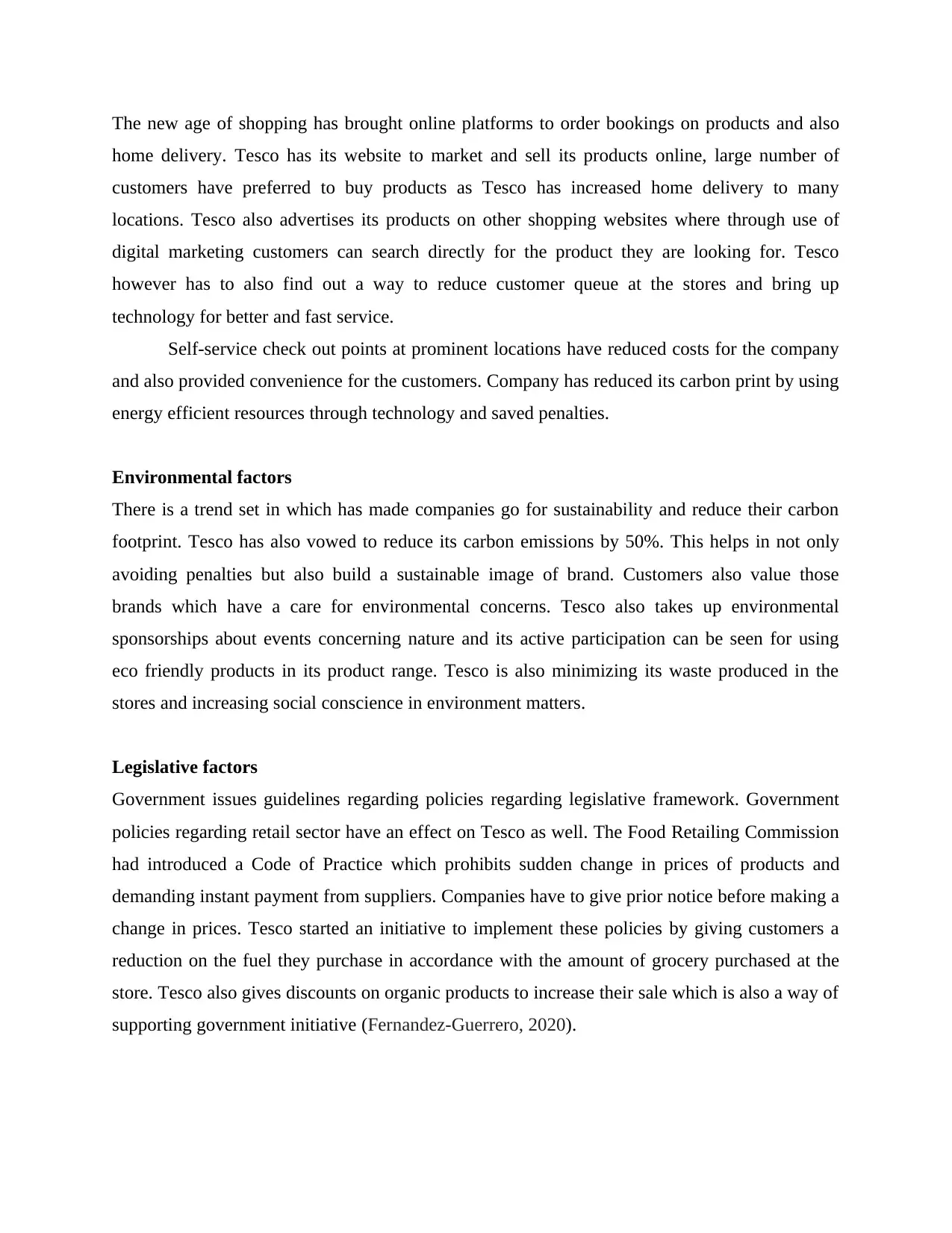
The new age of shopping has brought online platforms to order bookings on products and also
home delivery. Tesco has its website to market and sell its products online, large number of
customers have preferred to buy products as Tesco has increased home delivery to many
locations. Tesco also advertises its products on other shopping websites where through use of
digital marketing customers can search directly for the product they are looking for. Tesco
however has to also find out a way to reduce customer queue at the stores and bring up
technology for better and fast service.
Self-service check out points at prominent locations have reduced costs for the company
and also provided convenience for the customers. Company has reduced its carbon print by using
energy efficient resources through technology and saved penalties.
Environmental factors
There is a trend set in which has made companies go for sustainability and reduce their carbon
footprint. Tesco has also vowed to reduce its carbon emissions by 50%. This helps in not only
avoiding penalties but also build a sustainable image of brand. Customers also value those
brands which have a care for environmental concerns. Tesco also takes up environmental
sponsorships about events concerning nature and its active participation can be seen for using
eco friendly products in its product range. Tesco is also minimizing its waste produced in the
stores and increasing social conscience in environment matters.
Legislative factors
Government issues guidelines regarding policies regarding legislative framework. Government
policies regarding retail sector have an effect on Tesco as well. The Food Retailing Commission
had introduced a Code of Practice which prohibits sudden change in prices of products and
demanding instant payment from suppliers. Companies have to give prior notice before making a
change in prices. Tesco started an initiative to implement these policies by giving customers a
reduction on the fuel they purchase in accordance with the amount of grocery purchased at the
store. Tesco also gives discounts on organic products to increase their sale which is also a way of
supporting government initiative (Fernandez-Guerrero, 2020).
home delivery. Tesco has its website to market and sell its products online, large number of
customers have preferred to buy products as Tesco has increased home delivery to many
locations. Tesco also advertises its products on other shopping websites where through use of
digital marketing customers can search directly for the product they are looking for. Tesco
however has to also find out a way to reduce customer queue at the stores and bring up
technology for better and fast service.
Self-service check out points at prominent locations have reduced costs for the company
and also provided convenience for the customers. Company has reduced its carbon print by using
energy efficient resources through technology and saved penalties.
Environmental factors
There is a trend set in which has made companies go for sustainability and reduce their carbon
footprint. Tesco has also vowed to reduce its carbon emissions by 50%. This helps in not only
avoiding penalties but also build a sustainable image of brand. Customers also value those
brands which have a care for environmental concerns. Tesco also takes up environmental
sponsorships about events concerning nature and its active participation can be seen for using
eco friendly products in its product range. Tesco is also minimizing its waste produced in the
stores and increasing social conscience in environment matters.
Legislative factors
Government issues guidelines regarding policies regarding legislative framework. Government
policies regarding retail sector have an effect on Tesco as well. The Food Retailing Commission
had introduced a Code of Practice which prohibits sudden change in prices of products and
demanding instant payment from suppliers. Companies have to give prior notice before making a
change in prices. Tesco started an initiative to implement these policies by giving customers a
reduction on the fuel they purchase in accordance with the amount of grocery purchased at the
store. Tesco also gives discounts on organic products to increase their sale which is also a way of
supporting government initiative (Fernandez-Guerrero, 2020).
⊘ This is a preview!⊘
Do you want full access?
Subscribe today to unlock all pages.

Trusted by 1+ million students worldwide
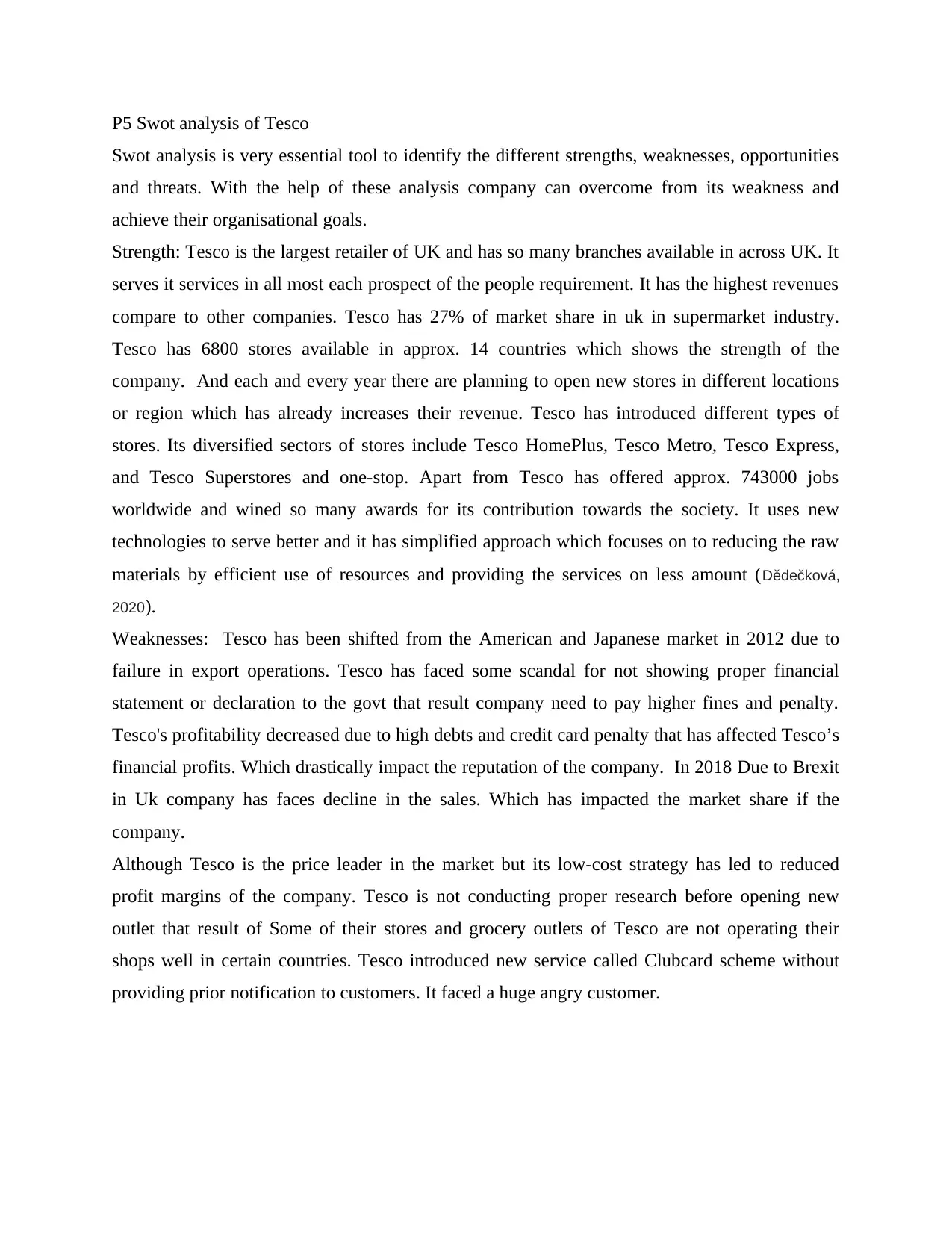
P5 Swot analysis of Tesco
Swot analysis is very essential tool to identify the different strengths, weaknesses, opportunities
and threats. With the help of these analysis company can overcome from its weakness and
achieve their organisational goals.
Strength: Tesco is the largest retailer of UK and has so many branches available in across UK. It
serves it services in all most each prospect of the people requirement. It has the highest revenues
compare to other companies. Tesco has 27% of market share in uk in supermarket industry.
Tesco has 6800 stores available in approx. 14 countries which shows the strength of the
company. And each and every year there are planning to open new stores in different locations
or region which has already increases their revenue. Tesco has introduced different types of
stores. Its diversified sectors of stores include Tesco HomePlus, Tesco Metro, Tesco Express,
and Tesco Superstores and one-stop. Apart from Tesco has offered approx. 743000 jobs
worldwide and wined so many awards for its contribution towards the society. It uses new
technologies to serve better and it has simplified approach which focuses on to reducing the raw
materials by efficient use of resources and providing the services on less amount (Dědečková,
2020).
Weaknesses: Tesco has been shifted from the American and Japanese market in 2012 due to
failure in export operations. Tesco has faced some scandal for not showing proper financial
statement or declaration to the govt that result company need to pay higher fines and penalty.
Tesco's profitability decreased due to high debts and credit card penalty that has affected Tesco’s
financial profits. Which drastically impact the reputation of the company. In 2018 Due to Brexit
in Uk company has faces decline in the sales. Which has impacted the market share if the
company.
Although Tesco is the price leader in the market but its low-cost strategy has led to reduced
profit margins of the company. Tesco is not conducting proper research before opening new
outlet that result of Some of their stores and grocery outlets of Tesco are not operating their
shops well in certain countries. Tesco introduced new service called Clubcard scheme without
providing prior notification to customers. It faced a huge angry customer.
Swot analysis is very essential tool to identify the different strengths, weaknesses, opportunities
and threats. With the help of these analysis company can overcome from its weakness and
achieve their organisational goals.
Strength: Tesco is the largest retailer of UK and has so many branches available in across UK. It
serves it services in all most each prospect of the people requirement. It has the highest revenues
compare to other companies. Tesco has 27% of market share in uk in supermarket industry.
Tesco has 6800 stores available in approx. 14 countries which shows the strength of the
company. And each and every year there are planning to open new stores in different locations
or region which has already increases their revenue. Tesco has introduced different types of
stores. Its diversified sectors of stores include Tesco HomePlus, Tesco Metro, Tesco Express,
and Tesco Superstores and one-stop. Apart from Tesco has offered approx. 743000 jobs
worldwide and wined so many awards for its contribution towards the society. It uses new
technologies to serve better and it has simplified approach which focuses on to reducing the raw
materials by efficient use of resources and providing the services on less amount (Dědečková,
2020).
Weaknesses: Tesco has been shifted from the American and Japanese market in 2012 due to
failure in export operations. Tesco has faced some scandal for not showing proper financial
statement or declaration to the govt that result company need to pay higher fines and penalty.
Tesco's profitability decreased due to high debts and credit card penalty that has affected Tesco’s
financial profits. Which drastically impact the reputation of the company. In 2018 Due to Brexit
in Uk company has faces decline in the sales. Which has impacted the market share if the
company.
Although Tesco is the price leader in the market but its low-cost strategy has led to reduced
profit margins of the company. Tesco is not conducting proper research before opening new
outlet that result of Some of their stores and grocery outlets of Tesco are not operating their
shops well in certain countries. Tesco introduced new service called Clubcard scheme without
providing prior notification to customers. It faced a huge angry customer.
Paraphrase This Document
Need a fresh take? Get an instant paraphrase of this document with our AI Paraphraser
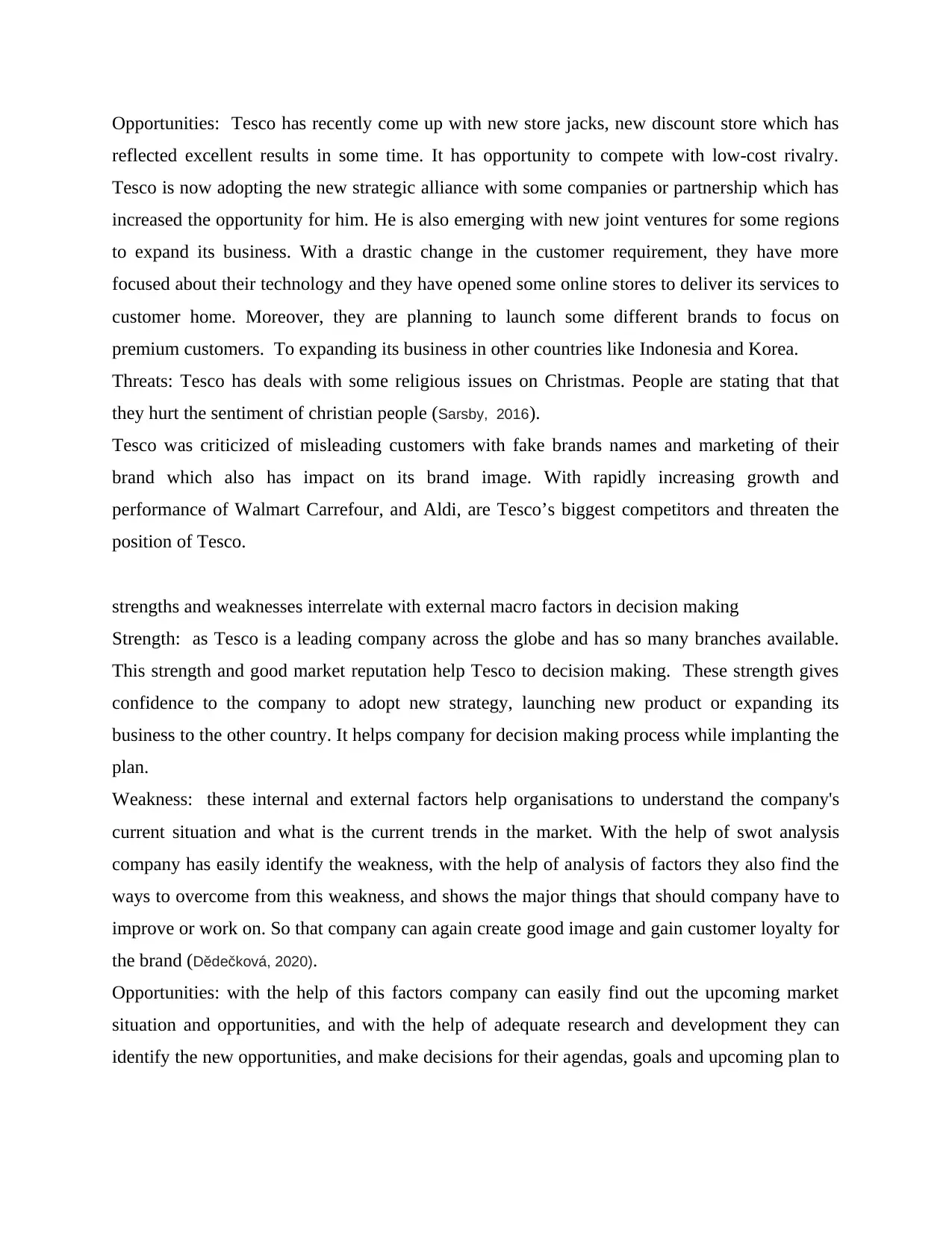
Opportunities: Tesco has recently come up with new store jacks, new discount store which has
reflected excellent results in some time. It has opportunity to compete with low-cost rivalry.
Tesco is now adopting the new strategic alliance with some companies or partnership which has
increased the opportunity for him. He is also emerging with new joint ventures for some regions
to expand its business. With a drastic change in the customer requirement, they have more
focused about their technology and they have opened some online stores to deliver its services to
customer home. Moreover, they are planning to launch some different brands to focus on
premium customers. To expanding its business in other countries like Indonesia and Korea.
Threats: Tesco has deals with some religious issues on Christmas. People are stating that that
they hurt the sentiment of christian people (Sarsby, 2016).
Tesco was criticized of misleading customers with fake brands names and marketing of their
brand which also has impact on its brand image. With rapidly increasing growth and
performance of Walmart Carrefour, and Aldi, are Tesco’s biggest competitors and threaten the
position of Tesco.
strengths and weaknesses interrelate with external macro factors in decision making
Strength: as Tesco is a leading company across the globe and has so many branches available.
This strength and good market reputation help Tesco to decision making. These strength gives
confidence to the company to adopt new strategy, launching new product or expanding its
business to the other country. It helps company for decision making process while implanting the
plan.
Weakness: these internal and external factors help organisations to understand the company's
current situation and what is the current trends in the market. With the help of swot analysis
company has easily identify the weakness, with the help of analysis of factors they also find the
ways to overcome from this weakness, and shows the major things that should company have to
improve or work on. So that company can again create good image and gain customer loyalty for
the brand (Dědečková, 2020).
Opportunities: with the help of this factors company can easily find out the upcoming market
situation and opportunities, and with the help of adequate research and development they can
identify the new opportunities, and make decisions for their agendas, goals and upcoming plan to
reflected excellent results in some time. It has opportunity to compete with low-cost rivalry.
Tesco is now adopting the new strategic alliance with some companies or partnership which has
increased the opportunity for him. He is also emerging with new joint ventures for some regions
to expand its business. With a drastic change in the customer requirement, they have more
focused about their technology and they have opened some online stores to deliver its services to
customer home. Moreover, they are planning to launch some different brands to focus on
premium customers. To expanding its business in other countries like Indonesia and Korea.
Threats: Tesco has deals with some religious issues on Christmas. People are stating that that
they hurt the sentiment of christian people (Sarsby, 2016).
Tesco was criticized of misleading customers with fake brands names and marketing of their
brand which also has impact on its brand image. With rapidly increasing growth and
performance of Walmart Carrefour, and Aldi, are Tesco’s biggest competitors and threaten the
position of Tesco.
strengths and weaknesses interrelate with external macro factors in decision making
Strength: as Tesco is a leading company across the globe and has so many branches available.
This strength and good market reputation help Tesco to decision making. These strength gives
confidence to the company to adopt new strategy, launching new product or expanding its
business to the other country. It helps company for decision making process while implanting the
plan.
Weakness: these internal and external factors help organisations to understand the company's
current situation and what is the current trends in the market. With the help of swot analysis
company has easily identify the weakness, with the help of analysis of factors they also find the
ways to overcome from this weakness, and shows the major things that should company have to
improve or work on. So that company can again create good image and gain customer loyalty for
the brand (Dědečková, 2020).
Opportunities: with the help of this factors company can easily find out the upcoming market
situation and opportunities, and with the help of adequate research and development they can
identify the new opportunities, and make decisions for their agendas, goals and upcoming plan to
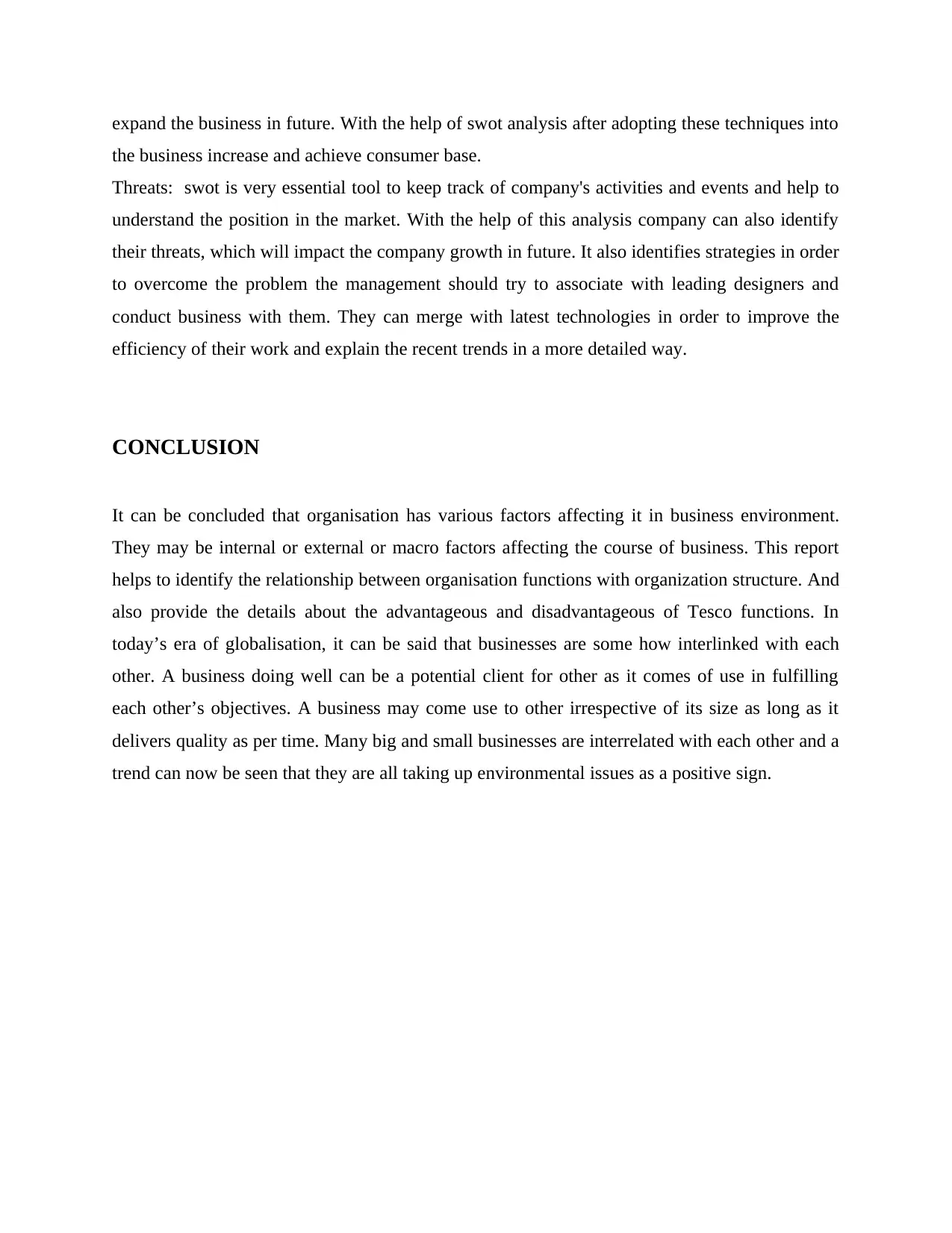
expand the business in future. With the help of swot analysis after adopting these techniques into
the business increase and achieve consumer base.
Threats: swot is very essential tool to keep track of company's activities and events and help to
understand the position in the market. With the help of this analysis company can also identify
their threats, which will impact the company growth in future. It also identifies strategies in order
to overcome the problem the management should try to associate with leading designers and
conduct business with them. They can merge with latest technologies in order to improve the
efficiency of their work and explain the recent trends in a more detailed way.
CONCLUSION
It can be concluded that organisation has various factors affecting it in business environment.
They may be internal or external or macro factors affecting the course of business. This report
helps to identify the relationship between organisation functions with organization structure. And
also provide the details about the advantageous and disadvantageous of Tesco functions. In
today’s era of globalisation, it can be said that businesses are some how interlinked with each
other. A business doing well can be a potential client for other as it comes of use in fulfilling
each other’s objectives. A business may come use to other irrespective of its size as long as it
delivers quality as per time. Many big and small businesses are interrelated with each other and a
trend can now be seen that they are all taking up environmental issues as a positive sign.
the business increase and achieve consumer base.
Threats: swot is very essential tool to keep track of company's activities and events and help to
understand the position in the market. With the help of this analysis company can also identify
their threats, which will impact the company growth in future. It also identifies strategies in order
to overcome the problem the management should try to associate with leading designers and
conduct business with them. They can merge with latest technologies in order to improve the
efficiency of their work and explain the recent trends in a more detailed way.
CONCLUSION
It can be concluded that organisation has various factors affecting it in business environment.
They may be internal or external or macro factors affecting the course of business. This report
helps to identify the relationship between organisation functions with organization structure. And
also provide the details about the advantageous and disadvantageous of Tesco functions. In
today’s era of globalisation, it can be said that businesses are some how interlinked with each
other. A business doing well can be a potential client for other as it comes of use in fulfilling
each other’s objectives. A business may come use to other irrespective of its size as long as it
delivers quality as per time. Many big and small businesses are interrelated with each other and a
trend can now be seen that they are all taking up environmental issues as a positive sign.
⊘ This is a preview!⊘
Do you want full access?
Subscribe today to unlock all pages.

Trusted by 1+ million students worldwide
1 out of 15
Related Documents
Your All-in-One AI-Powered Toolkit for Academic Success.
+13062052269
info@desklib.com
Available 24*7 on WhatsApp / Email
![[object Object]](/_next/static/media/star-bottom.7253800d.svg)
Unlock your academic potential
Copyright © 2020–2025 A2Z Services. All Rights Reserved. Developed and managed by ZUCOL.




